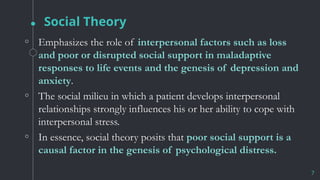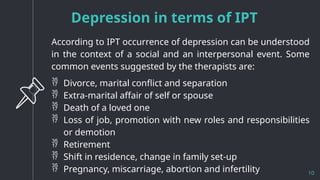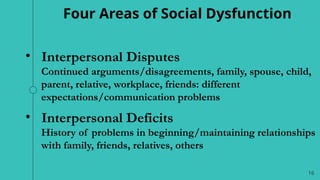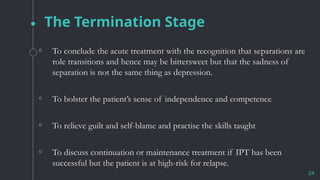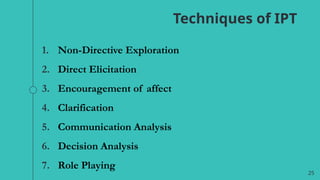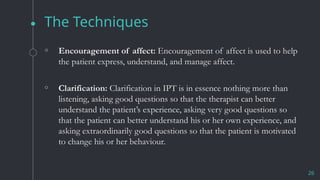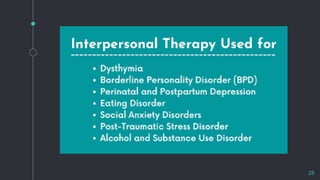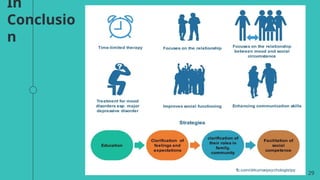M.Phil clinical Psychology Interpersonal Therapy 1.pptx
- 2. Contents - Development of IPT - Theoretical Background of IPT - IPT developed as a treatment of depression - Target areas of IPT - Process of IPT - Techniques of IPT - Applications of IPT 2
- 3. What is Interpersonal Therapy? Interpersonal Psychotherapy (IPT) was developed by Gerald Klerman and Myrna Weissman for major depression in the 1970s and has since been adapted for other mental disorders. It is a time-limited (12-16 weeks) and highly structured evidence based psychotherapy. 3
- 4. Theoretical Background of IPT 1 4
- 5. Attachment Theory Attachment theory describes the way in which individuals form, maintain, and end relationships and is based on the premise that humans have an intrinsic drive to form interpersonal relationships with others. Attachment theory hypothesizes that people experience distress when disruptions in their attachments with others occur. This is both because of the problems within the specific relationship and because their social support network is not able to sustain them during the loss, conflict, or transition 5
- 6. Communication Theory 6 ◦ Communication theory can be understood as describing the way in which individuals communicate their attachment needs to specific significant others. ◦ Attachment (social/macro level) is the template on which specific communication (micro level) occurs. ◦ According to Kiesler, interpersonal problems occur as a result of negative or non-supportive responses from others that are elicited unintentionally by the patient. ◦ Maladaptive attachment styles lead to inappropriate or inadequate interpersonal communication, which prevents a person’s attachment needs from being met.
- 7. Social Theory 7 ◦ Emphasizes the role of interpersonal factors such as loss and poor or disrupted social support in maladaptive responses to life events and the genesis of depression and anxiety. ◦ The social milieu in which a patient develops interpersonal relationships strongly influences his or her ability to cope with interpersonal stress. ◦ In essence, social theory posits that poor social support is a causal factor in the genesis of psychological distress.
- 9. IPT- Thrust Areas 9 ◦ Understand the interpersonal context in which the depressive symptoms arose ◦ How they relate to the current social and personal context ◦ Focusses on IPR in current scenario (here and now) ◦ Encourage coping with these current problems and the development of self-reliance outside of the therapeutic situation
- 10. Depression in terms of IPT 10 According to IPT occurrence of depression can be understood in the context of a social and an interpersonal event. Some common events suggested by the therapists are: Divorce, marital conflict and separation Extra-marital affair of self or spouse Death of a loved one Loss of job, promotion with new roles and responsibilities or demotion Retirement Shift in residence, change in family set-up Pregnancy, miscarriage, abortion and infertility
- 11. Depression in terms of IPT Symptoms: The emotional, cognitive & physical symptoms of depression Social and Interpersonal Life: The ability to get along with other important people in the patient’s life (e.g., family, friends, and work associates). Social supports protect against depression, whereas social stressors increase vulnerability for depression. Personality: Enduring patterns with which people deal with life: how they assert themselves, express their anger, maintain their self-esteem, and whether they are shy, aggressive, inhibited or suspicious. These interpersonal patterns may contribute to developing or maintaining depression. 11
- 12. 12
- 13. The Initial Stage • Review of depressive symptoms and make a diagnosis • Explaining the diagnosis and various treatments • Evaluate the need for medication • Review the patient’s current problems in relationship to depression • Presenting the formulation • Making the treatment context and explaining what to expect • The sick role 13
- 14. 14 The Middle and Acute Stage - Assessment - Conceptualization of assessment findings - Therapeutic Formulation - Psychoeducation - Therapeutic Treatments
- 15. 15 Four Areas of Social Dysfunction • Grief Loss through death, bereavement, grief reactions, complicated bereavement Difficulties for people in mourning when reaction is severe and continuous for long time • Role Transitions situations to adapt to life changes: planned / unplanned / accidental (developing serious illness, fire/flood) (going to college, marital status, children leaving home,
- 16. 16 Four Areas of Social Dysfunction • Interpersonal Disputes Continued arguments/disagreements, family, spouse, child, parent, relative, workplace, friends: different expectations/communication problems • Interpersonal Deficits History of problems in beginning/maintaining relationships with family, friends, relatives, others
- 17. 17 CASE EXAMPLE Multiple Miscarriages Infertility Treatment Passive, Introverted Failed Adoptions Lack of Assertiveness Death of Mother-in-Law Socially Shy Dominating Husband - Yelling., Arguments Unemployed – wanted to be a teacher Dependent on Husband (earlier on brother) Lack of Friends due to focus on infertility treatment Mrs M 39 year old Married for 12 years, no children, MSES, M.Sc. housewife
- 18. 18 Findings of Interpersonal Questionnaire/ Assessment Conceptualization
- 19. 19 Interpersonal Therapy: Therapeutic Formulation
- 20. IPT Problem Areas Interperson al Disputes Grief & Loss Role Disputes & Transition s 20
- 21. GRIEF & LOSS – How to address? 21 To facilitate mourning (catharsis) - Many patients fear that, if they begin to cry or mourn, they will not be able to stop and that the wave of grief will overwhelm them. It is important to reassure them about this. Re-establishing interests and relationships - Social supports are important and reviving old existing ties or undertaking a new activity or relationship will be helpful in resolving grief reaction. Depressed patients who have an unresolved grief reaction may fear abandonment in new relationships. A prospective new or revived relationship should be discussed, including fears about them. Similarly, discuss activities that make the patient feel comfortable and those the patient fears.
- 22. INTERPERSONAL DISPUTES – How to address? 22 Impasse when the discussion between the patient and the other person has stopped. There is low-level resentment and hopeless resignation but no attempt to renegotiate the relationships Renegotiation the parties are in active contact with the differences Dissolution when the relationship is irretrievably disrupted by the dispute and one or both parties actively strive to terminate it through divorce or separation, by leaving an intolerable work situation The goals to target interpersonal disputes are to help the patient first identify the disagreement, one’s communication pattern, and invalid/unrealistic expectations, choose a plan of action, and finally modify communication or expectations or both so that the difference of opinion is resolved. IP Deficit - modify problematic relationship patterns like excess dependency or hostility. The patient must realise and accept that the problem doesn’t lie entirely with him or her.
- 23. ROLE DISPUTE AND TRANSITIONS – How to address? 23 The strategy in dealing with role transitions is to help the patient mourn the loss of the old role and develop a more balanced view of both the old and new roles. Encouraging the patient to develop/modify new sources of social supports in his or her new environment also is crucial. Develop necessary skills for adopting the new role.
- 24. The Termination Stage ◦ To conclude the acute treatment with the recognition that separations are role transitions and hence may be bittersweet but that the sadness of separation is not the same thing as depression. ◦ To bolster the patient’s sense of independence and competence ◦ To relieve guilt and self-blame and practise the skills taught ◦ To discuss continuation or maintenance treatment if IPT has been successful but the patient is at high-risk for relapse. 24
- 25. 25 Techniques of IPT 1. Non-Directive Exploration 2. Direct Elicitation 3. Encouragement of affect 4. Clarification 5. Communication Analysis 6. Decision Analysis 7. Role Playing
- 26. The Techniques 26 ◦ Encouragement of affect: Encouragement of affect is used to help the patient express, understand, and manage affect. ◦ Clarification: Clarification in IPT is in essence nothing more than listening, asking good questions so that the therapist can better understand the patient’s experience, asking very good questions so that the patient can better understand his or her own experience, and asking extraordinarily good questions so that the patient is motivated to change his or her behaviour.
- 27. The Techniques 27 ◦ Communication Analysis: Communication analysis is simply a structured method of investigating the hypothesis that the patient’s difficulties are being caused, perpetuated, or exacerbated by poor communication. ◦ Decision Analysis: This technique helps the patient to consider alternative courses of actions and their consequences in order to solve a given problem. The patient can learn to use the decision-making skill not only within the treatment but also as a general interpersonal skill. Questions such as “What would you want to happen?”, may be helpful.
- 28. 28
- 30. 30 THANK YOU






